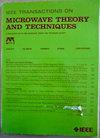夹芯-耦合器- balun和折叠t线功率合流器ka波段功率放大器的设计与分析
IF 4.1
1区 工程技术
Q2 ENGINEERING, ELECTRICAL & ELECTRONIC
IEEE Transactions on Microwave Theory and Techniques
Pub Date : 2024-10-03
DOI:10.1109/TMTT.2024.3465932
引用次数: 0
摘要
提出了一种基于130纳米SiGe BiCMOS工艺的双向电流组合ka波段功率放大器。利用夹芯耦合器平衡(SCB)和折叠t线(又称曲线)组成的双向功率组合网络,实现了高阻抗转换比下的低损耗宽带大信号阻抗匹配。级联放大器还采用并联峰值电感来提高功率增益和效率,并在设计过程中考虑了峰值电感的质量因子(Q因子)。利用驱动级和两个输出级之间的对称级间匹配网络(ISMN)来提高宽带下的大信号性能。测量结果表明,该放大器在34.8 GHz时的峰值小信号增益为30.5 dB, 3db带宽为10 GHz (31-41 GHz)。在35 GHz时,PA实现23.5 dbm Psat,峰值功率增加效率(PAE)为33.9%,OP1dB为22.2 dbm。在31 ~ 39 GHz范围内,PA的Psat和峰值PAE分别保持22.7 ~ 23.8 dBm和24.5% ~ 33.9%。对于调制信号测试,该PA在35/37/39 GHz和250 msym /s 64二次调幅(QAM)信号下显示了- 25.4-/ - 26.1-/ - 25.4 db rms误差矢量幅度(EVM)和- 25.3-/ - 27.5-/ - 25.3 dbc邻接通道漏功率比(ACLR),并在35/37/39 GHz和400 msym /s 64-QAM信号下显示了- 25.3-/ - 25.1-/ - 25.3 db rms EVM和- 26.3-/ - 27.7-/ - 27.1 dbc ACLR。本文章由计算机程序翻译,如有差异,请以英文原文为准。
Design and Analysis of Ka-Band Power Amplifier With Sandwiched-Coupler-Balun and Folded-T-Line Power Combiner
This article presents a two-way current-combining Ka-band power amplifier (PA) in a 130-nm SiGe BiCMOS process. A two-way power-combining network composed of sandwiched-coupler-balun (SCB) and folded-T-line (also known as meander line) is utilized to realize low-loss broadband large-signal impedance matching under a high impedance transformation ratio. Parallel peaking inductance is also employed in the cascode amplifiers to improve the power gain and efficiency, and the quality factor (Q factor) of the peaking inductance is considered during the design process. The symmetrical interstage matching network (ISMN) between the driver and two output stages (OAs) is utilized to improve large-signal performance under broadband operation. The measurement result shows that the proposed PA has a peak small-signal gain of 30.5 dB at 34.8 GHz and a 3-dB bandwidth of 10 GHz (31–41 GHz). At 35 GHz, the PA achieves a 23.5-dBm Psat with 33.9% peak power added efficiency (PAE) and 22.2-dBm OP1dB. Across 31–39 GHz, the Psat and peak PAE of the PA remain 22.7–23.8 dBm and 24.5%–33.9%, respectively. For modulated signal tests, this PA demonstrates −25.4-/ −26.1-/−25.4-dB rms error vector magnitude (EVM) and −25.3-/−27.5-/−25.3-dBc adjacent-channel power leakage ratio (ACLR) at 35/37/39 GHz with a 250-MSym/s 64-quadratic-amplitude modulation (QAM) signal, and it also demonstrates −25.3-/−25.1-/−25.3-dB rms EVM and −26.3-/−27.7-/−27.1-dBc ACLR at 35/37/39 GHz with a 400-MSym/s 64-QAM signal.
求助全文
通过发布文献求助,成功后即可免费获取论文全文。
去求助
来源期刊

IEEE Transactions on Microwave Theory and Techniques
工程技术-工程:电子与电气
CiteScore
8.60
自引率
18.60%
发文量
486
审稿时长
6 months
期刊介绍:
The IEEE Transactions on Microwave Theory and Techniques focuses on that part of engineering and theory associated with microwave/millimeter-wave components, devices, circuits, and systems involving the generation, modulation, demodulation, control, transmission, and detection of microwave signals. This includes scientific, technical, and industrial, activities. Microwave theory and techniques relates to electromagnetic waves usually in the frequency region between a few MHz and a THz; other spectral regions and wave types are included within the scope of the Society whenever basic microwave theory and techniques can yield useful results. Generally, this occurs in the theory of wave propagation in structures with dimensions comparable to a wavelength, and in the related techniques for analysis and design.
 求助内容:
求助内容: 应助结果提醒方式:
应助结果提醒方式:


